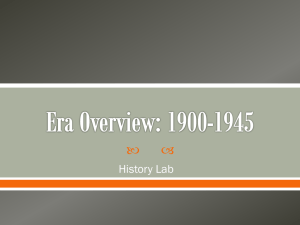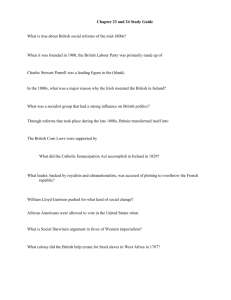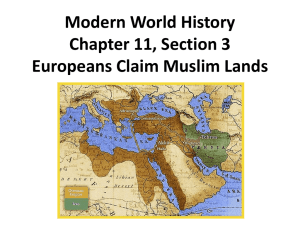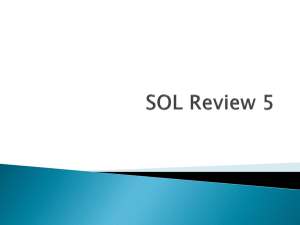Questions for the PowerPoint Europe and the Age of Imperialism Teacher Key
advertisement
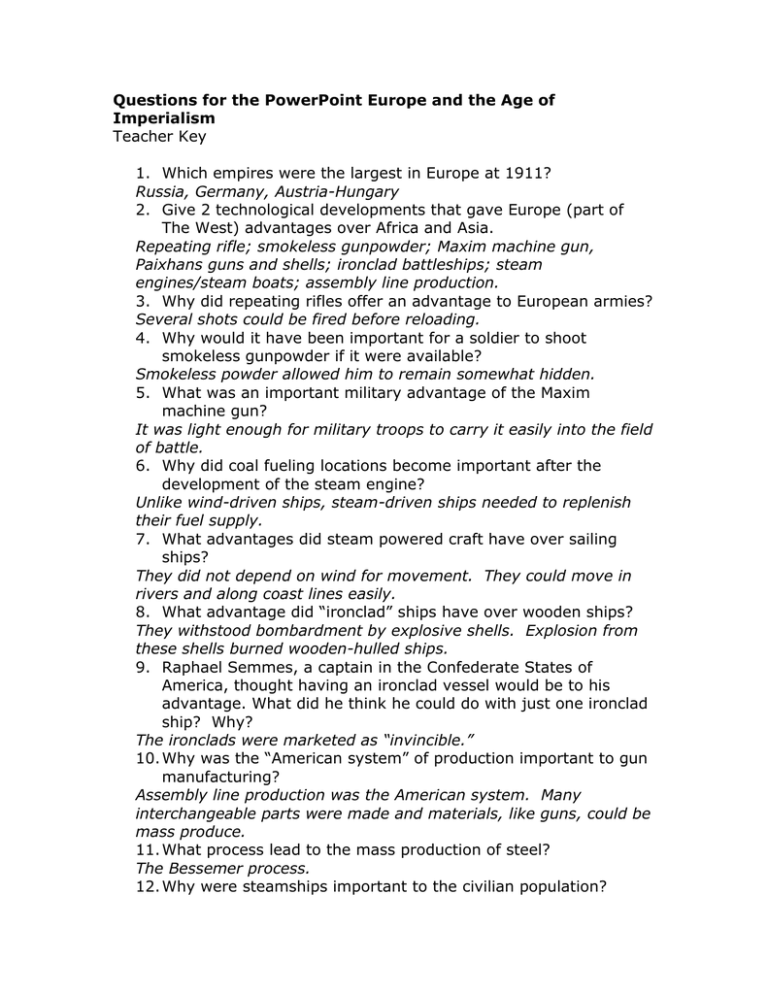
Questions for the PowerPoint Europe and the Age of Imperialism Teacher Key 1. Which empires were the largest in Europe at 1911? Russia, Germany, Austria-Hungary 2. Give 2 technological developments that gave Europe (part of The West) advantages over Africa and Asia. Repeating rifle; smokeless gunpowder; Maxim machine gun, Paixhans guns and shells; ironclad battleships; steam engines/steam boats; assembly line production. 3. Why did repeating rifles offer an advantage to European armies? Several shots could be fired before reloading. 4. Why would it have been important for a soldier to shoot smokeless gunpowder if it were available? Smokeless powder allowed him to remain somewhat hidden. 5. What was an important military advantage of the Maxim machine gun? It was light enough for military troops to carry it easily into the field of battle. 6. Why did coal fueling locations become important after the development of the steam engine? Unlike wind-driven ships, steam-driven ships needed to replenish their fuel supply. 7. What advantages did steam powered craft have over sailing ships? They did not depend on wind for movement. They could move in rivers and along coast lines easily. 8. What advantage did “ironclad” ships have over wooden ships? They withstood bombardment by explosive shells. Explosion from these shells burned wooden-hulled ships. 9. Raphael Semmes, a captain in the Confederate States of America, thought having an ironclad vessel would be to his advantage. What did he think he could do with just one ironclad ship? Why? The ironclads were marketed as “invincible.” 10. Why was the “American system” of production important to gun manufacturing? Assembly line production was the American system. Many interchangeable parts were made and materials, like guns, could be mass produce. 11. What process lead to the mass production of steel? The Bessemer process. 12. Why were steamships important to the civilian population? Civilians began to travel to explore new lands. No longer was such travel just for traders, military, missionaries, and explorers. 13. What by-product of crude oil replaced whale oil in the 1880s? Kerosene took the place of whale oil in the 1880s. 14. Why is the cartoon in slide ____ captioned, “The New Siamese Twins?” What countries are being connected by the English Channel Cable? England and France are being “joined at the hip” like Siamese twins. 15. In what year was the placement of the transatlantic cable completed? The placement of the transatlantic cable was completed in 1866. 16. Why was it important to have brass cartridges instead of paper cartridges when fighting in tropical climates? Tropical humidity easily destroyed paper cartridges. Brass cartridges could withstand humidity. 17. What drug was used to fight malaria? Quinine. 18. Define the word “imperialism” in your own words. Responses will vary. 19. What was the goal of imperialism in the 19th and early 20th century? The goal was to create new colonies or outposts. 20. Why did European countries want colonies or outposts? Economically profitable colonies or outposts would increase a country’s/empire’s wealth. 21. What are the 2 types of colonies? Two types of colonies are direct rule and indirect rule. 22. How was a protectorate different from an area in a country’s sphere of influence? A protectorate was a territory where local rulers were expected to follow the advice of European powers. A sphere of influence is an area claimed for investment or trade privileges. 23. How was Charles Darwin’s theory of evolution used to justify imperialism? Darwin’s theory of evolution is about survival of the fittest. Social Darwinism is also about survival of the fittest. The fit, strong nations of Europe should dominate the weaker nations of the world. The rich and powerful should dominate the poor and weak. 24. What did Rudyard Kipling mean by “White Man’s burden”? The burden was the weight of all the poor and uncivilized people of the world that the developed, rich, civilized world had to bear. 25. Which kingdoms were part of the African Trade States? The African trade states were Mali, Songhai, the Swahili states, and the Great Zimbabwe. 26. What trade goods traveled across the Sahara desert? Salt, gold, ivory, textiles, jewels, copper, and slaves were all part of the trans-Sahara trade. 27. What is the name of the Mali city that was a famous hub in the trans-Sahara trade? Timbuktu is the city in Mali. 28. Name three raw materials exported from Africa by European powers in the 19th and early 20th century. Rubber, ivory, copper, gold, diamonds, and oil were all extracted from Africa. 29. European powers were interest in Africa for many reasons. One was for trade/raw materials. What was another? Other reasons for being in Africa were to convert the population to Christianity and for science/exploration purposes. 30. According to the map of African Religions and Missions, 1913, where was the Christian part of Africa? The Christian area of Africa is located in southern Africa. 31. Who is the famous British missionary shown in slide ___? David Livingstone 32. In which part of Africa was “Mohammedan” the principal faith? Mohammedan faith (Islam) was practiced in north Africa. 33. Which people settled in southern Africa as early as 1652? The Dutch, German, and French Huguenots who called themselved Afrikaner. 34. Which company encouraged them to move to Africa? The Dutch East India Company solicited them to settle near the Cape of Good Hope. 35. What was/is the name of the settlement they founded near the Cape of Good Hope? Cape Town 36. What is the relative location of Johannesburg to the Cape of Good Hope? Johannesburg is northeast of the Cape of Good Hope in the province of Transvaal. 37. What did the British call the Afrikaners? Boers 38. What is the name given to the Boer migration across southern Africa? The Great Trek 39. What famous author was a British soldier in the Boer War? Arthur Conan Doyle, author of Sherlock Holmes! 40. What Boer homeland eventually became the Union of South Africa? The Transvaal. 41. What 2 natural resources were found in southern Africa that brought the area to British attention? Diamonds and gold. 42. Who was Cecil Rhodes? Rhodes was a British statesman and businessman. He held government office in South Africa and ran the De Beers Mining Company. 43. What was the De Beers Mining Company mining? Diamonds. 44. According to the quote by Lord Frederick Lugard, why was Africa important? Africa would provide a place for emigration for British citizens and would provide employment and trade opportunities. 45. What was the reason given for construction of a Cape to Cairo road? Such a road would have connected British holdings, north to south. 46. Where was oil being extracted in French controlled Africa? French were getting oil from the Ivory Coast. 47. What was the name of the French fighting force overseas? The French foreign legend fought overseas. 48. How would you compare French imperialism in northern Africa to the European imperialism in southern Africa? The French established outposts more than colonies. They extracted raw materials and ruled their areas with strict control. The British wanted to bring their culture to their colonies. 49. Which countries/empires were the main power brokers at the Berlin Conference? France, Germany, Great Britain, and Portugal were the main power brokers. 50. Why was Africa desirable to those participating in the conference? Africa was desirable for its raw materials and markets. 51. Who hosted the Berlin Conference? Otto von Bismarck of Germany. 52. Which Europeans were considered “objects of special protection”? Christian missionaries, scientists, and explorers. 53. What promises did King Leopold II make related to the Congo Free State? He promised to protect the native population, to end slavery, and to guarantee free trade for European powers. 54. What happened to the native African people of the Congo Free State while they were under Leopold’s control? Leopold allowed slave labor, rape and mutilation of native population, and torture of the population to force them to work. 55. Leopoldville was built on the banks of what major African river? The Congo River. 56. What two authors helped reveal the horrors of the Congo Free State? Mark Twain and Joseph Conrad 57. Name the European countries/empires that had colonies in Africa from 1885-1914. Britain, France, Germany, Portugal, Italy, Belgium, and Spain. 58. Locate the Tigris and Euphrates Rivers in slide ___. Which two seas are near the rivers headwaters? The Black Sea and the Caspian Sea. 59. Reference the area boxed off on the map titled The Macedonian Empire, 336-323 BC. The boxed area marks the watershed of the Tigris and Euphrates Rivers. Into what water body do the Tigris and Euphrates flow? The Persian Gulf 60. Who was Marco Polo? Polo was a European explorer who ventured to China and other places in East Asia in the late 1200s, early 1300s. 61. Why did Italians and Muslims have some control of the spice trade from India and Indonesia? They controlled the ports and cities of the eastern Mediterranean. 62. Name 2 spices imported from Indonesia. Cloves and nutmeg. 63. When did Vasco Da Gama land in India for the first time? 1498. 64. Give two reasons the Europeans succeeded in imperial conquests of Asia. They had advanced technology; strong, established military and merchant outposts around the Indian Ocean; there was profit to be made from spice trade; and the Europeans had a spirit of inquiry about new lands and people. 65. What was the name of the main British trading company? The British (or English) East India Company 66. Which trading company was established first? The Dutch East India company was established first in 1602. 67. What was the Ottoman Empire? The Ottoman Empire was an Islamic kingdom that stretched across north Africa, southwest Asia, and southeastern Europe. The Ottoman Empire ruled parts of southwest Asia and southeast Europe for centuries! 68. Why was Russia interested in expanding into southwest Asia? Though Russia has an extensive northern coast, it is effectively a landlocked country. This is because the northern coast is frozen for most of the year. Russia was after a warm water port. 69. Which German leader developed close ties with the Ottoman Empire? Kaiser Wilhelm II established trade relations with the Ottoman Empire, trading military weapons and military training for opportunities like railroad construction.. 70. Which country/empire planned to build the “Berlin to Baghdad” railroad? Germany 71. When did the English (British) East India Company establish a factory in Iraq? 1763. 72. On which river is Baghdad located? The Tigris River. 73. Why was Iraq (Mesopotamia) important to the British? To the Germans? To the Russian? Britain wanted secure overland trade routes to India. Germany wanted a railroad system to help it connect with its east African colonies. Russia wanted a way to a warm water port. 74. Who was the last Russian Tzar? Nicholas II 75. Who was the religious leader who advised the last Tzarina, Alexandra? Rasputin 76. When were British troops fighting in Afghanistan? 1839-42 and 1878-1880. 77. How was the Afghan city of Kabul (a.k.a. Cabul) naturally defended? Kabul is nestled behind some high, steep mountains. There are few passes that make access to Kabul possible. 78. Were British soldiers the only ones fighting for the British in India? The East India company had a fighting force. Also many natives fought for the British military. 79. From the historical images found in the section on India under British rule, how would you describe the British life-style in India? The British brought their “civilized” lifestyle and culture with them. They did not “go native” in India. 80. What trade item from India and Ceylon was exported to the British market? (Consumption of this item happens every afternoon in British society.) Tea. 81. What trade item from India was shipped to China in exchange for silks and other goods? Opium. 82. What transportation and communication innovations did the British bring to India? The British brought trains and railroads, mail service, banking, and a common language of rule (English) to India. 83. Name four plantation crops that were grown on the island of Ceylon for export to British markets. Rubber, tea, coconut, and cocoa (chocolate). 84. Compare the street scene in downtown Colombo to the “native section,” circa 1900. Describe the similarities and differences. Similarities—a street is shown in both places. Differences—the downtown Colombo scene shows a tidy, manicured environment with people properly dressed, using modern transportation. The “native section” appears to be crowded, full of people using buggies not rail for travel, carrying basket of goods on their heads. It seems unkept in comparison. 85. Which European country was influential in Burma? Britain. 86. Which European country colonized Siam? NONE! 87. Why would the British have been interested in building a Burma-Siam-China railway? It could open more trade routes to China. 88. What did the French call the area they colonized in southeast Asia? Indochina. 89. Name one export crop that was traded from French southeast Asia. Pepper and rubber are shown. 90. Who were the French leaders holding in prison or in stockades? Insurgents and pirates trying to steal exports from French ships. 91. Why did the Opium Wars occur? The Chinese rulers wanted to stop the British opium trade. 92. Who fought in the First Opium War? British fought the Chinese. 93. What was decided by the Treaty of Nanjing? Britain ceded Hong Kong; China opened port of Shanghai and 4 others to British trade and residence. 94. To what conditions did the Chinese agree at the end of the Second Opium War? China agreed to open 11 more ports and to permit foreign legations at Peking (Bejing); sanction Christian missionary activity; and to legalize the import of opium. 95. What lands did Russia annex at the end of the Second Opium War? Russia annexed Turkistan and Manchuria from China. 96. Why did Empress Dowager Tsu Hsi believe to be China’s main defense against invaders? She thought that the hundreds of millions of Chinese inhabitants would be able to stop the invaders. 97. Which countries/empires fought in the coalition against the Chinese in the Boxer Rebellion? Japan, US, Austria-Hungary, Britain, France, Germany, Italy, and Russia 98. What powers in the cartoon in slide _____ are “celebrating the fall of Peking, 1900”? From right to left: The US; Great Britain; Russia; Italy (?); Germany; and France. 99. Using the slide titled, ASIA , 1892, determine which empires/countries was (were) split, found in both Europe and Asia. Russia and Turkey (the Ottoman Empire) 100. Which European countries/empires had colonies in Asia in 1914? Britain, France, The Netherlands, Portugal, US, and Japan 101. Using the map in slide ___ , explain the saying, “The sun never sets on the British Empire.” Responses will vary. Basically, Britain controlled holdings across the globe!

